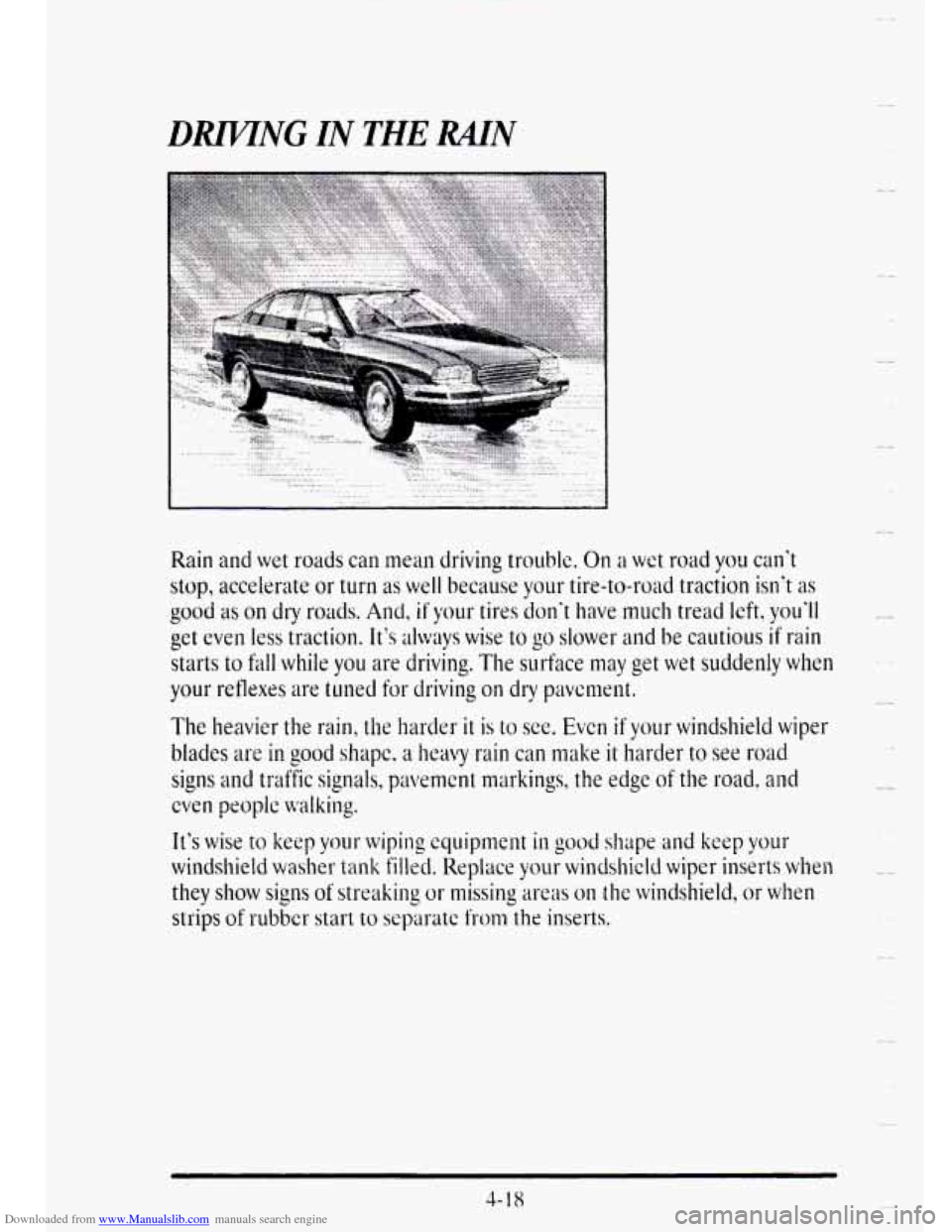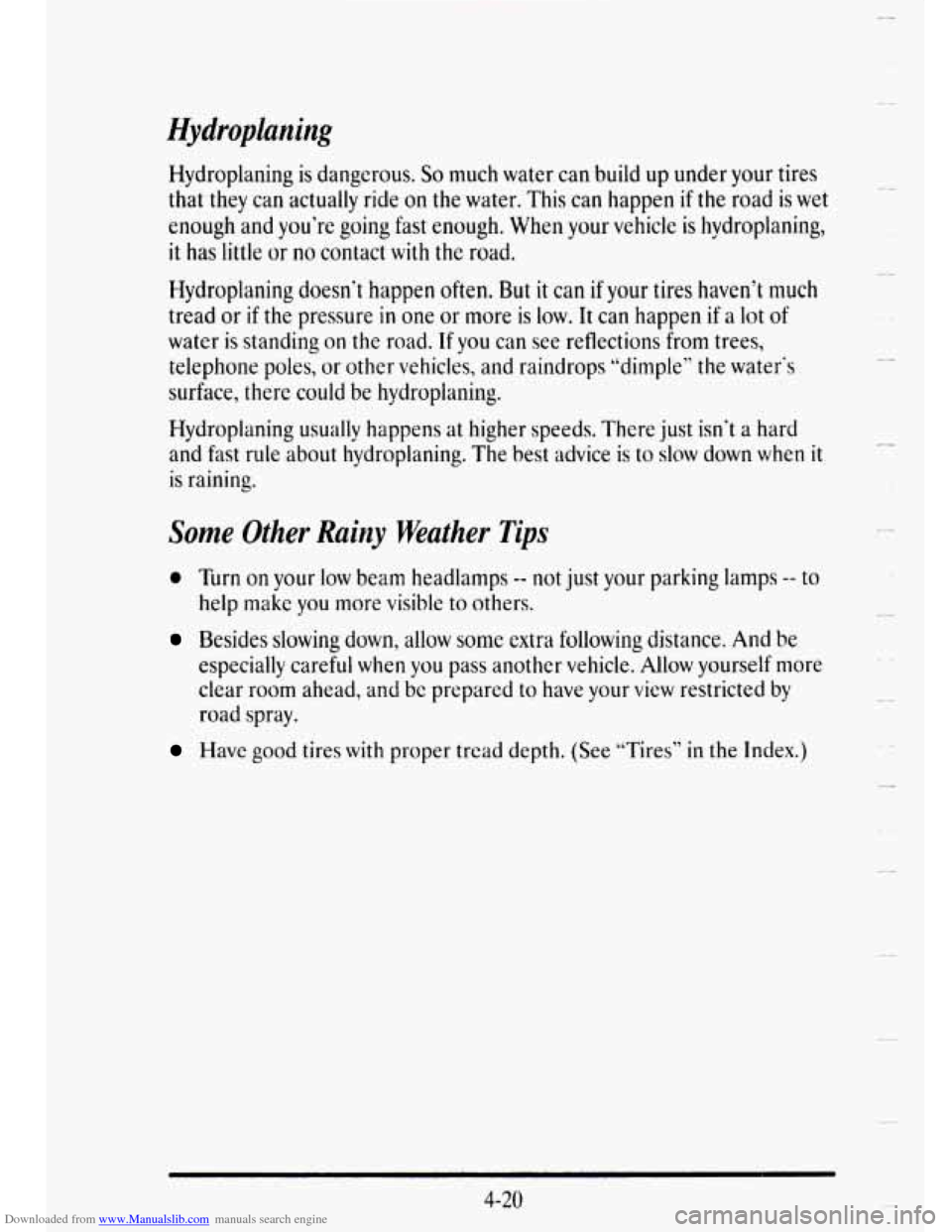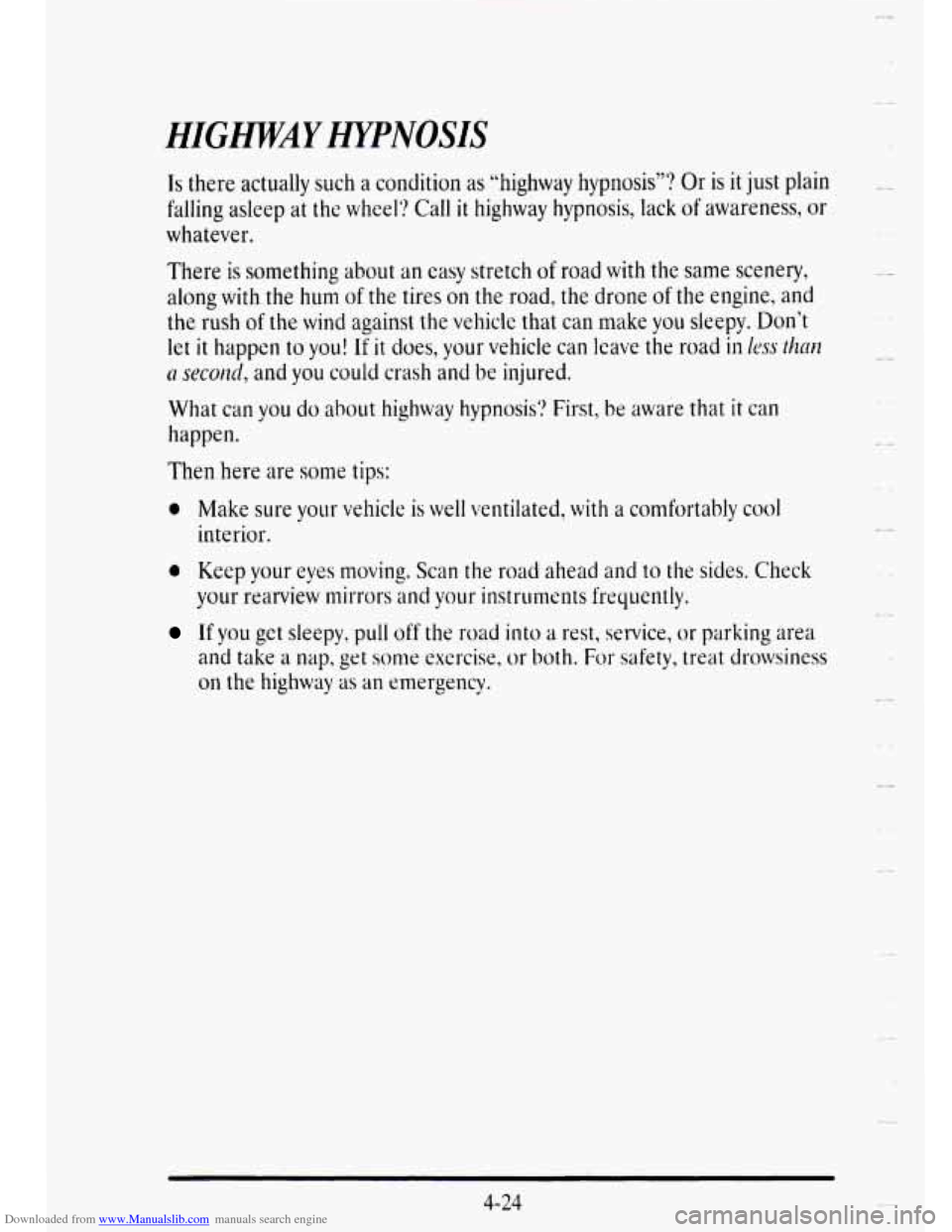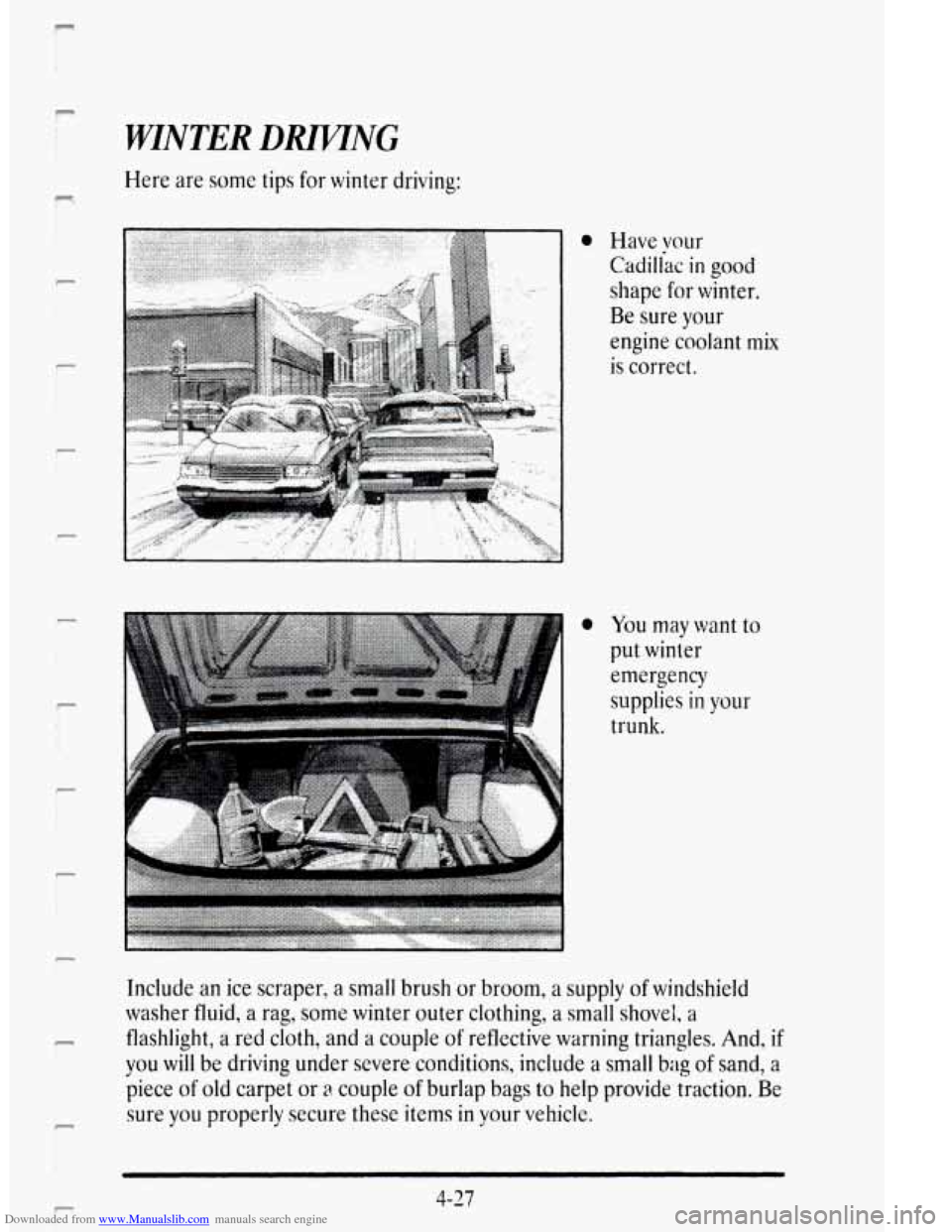CADILLAC DEVILLE 1995 7.G Owners Manual
Manufacturer: CADILLAC, Model Year: 1995, Model line: DEVILLE, Model: CADILLAC DEVILLE 1995 7.GPages: 403, PDF Size: 20.69 MB
Page 211 of 403

Downloaded from www.Manualslib.com manuals search engine DMNG IN THE RAIN
Rain and wet roads can mean driving trouble. On a wet road you can't
stop, accelerate or
turn as well because your tire-to-road traction isn't as
good as on dry roads. And, if your tires don't have much tread left, you'll
get even less traction. It's dwa~s wise to go slower and be cautious if rain
starts to fall while
you are driving. The surface may get wet suddenly when
your reflexes ;u'e tuned for driving on dry pavcment.
The heavier the rain, the harder it is to see. Even if your windshield wiper
blades are in
good shape, a heavy rain can make it harder to see road
signs and traffic signals, pavement markings, the edge of the road. and
cven peoplc walking.
It's wise to keep vour wiping quiptnent in good shape and keep your
windshield wash&
tank filled. Replace your windshield wiper inserts when
they show signs c. of streaking or missing areas on the windshield, or when
strips
of rubber start to separatc from the inserts.
3- 18
b4
Page 212 of 403

Downloaded from www.Manualslib.com manuals search engine 4- 19
Page 213 of 403

Downloaded from www.Manualslib.com manuals search engine Hydrupluning
Hydroplaning is dangerous. So much water can build up under your tires
that they can actually ride
on the water. This can happen if the road is wet
enough and you’re going fast enough. When your vehicle
is hydroplaning,
it has little or no contact with the road.
Hydroplaning doesn’t happen often. But it can if your tires haven‘t much
tread or
if the pressure in one or more is low. It can happen if a lot of
water
is standing on the road. If you can see reflections from trees,
telephone poles,
or other vehicles, and raindrops ‘‘dimple’‘ the water‘s
surface, there could be hydroplaning.
Hydroplaning
usually happens at higher speeds. There just isn‘t a hard
and fast
rule about hydroplaning. The best advice is to slow down when it
is raining.
Some Other Rainy Weather Tips
0 Turn on your low beam headlamps -- not just your parking lamps -- to
help
make you more visible to others.
Besides slowing down, allow some extra following distance. And be
especially careful when you pass another vehicle. Allow yourself more
clear
room ahead, and be prepared to have your view restricted by
road spray.
Have good tires with proper tread depth. (See “Tires” in the Index.)
4-20
Page 214 of 403

Downloaded from www.Manualslib.com manuals search engine CITYDRIVING
P
r I
P I
r
One of the biggest problems with city streets is the amount of traffic on
them. You’ll want to watch out for what the other drivers are doing and
pay attention to traffic signals.
Here are ways to increase your safety
in city driving:
0
F
i
a
a
Know the best way to get to where you are going. Gct a city map and
pian your trip into an unknown part
of the city just as you would for a
cross-country trip.
Try to use the freeways that rim and crisscross most large cities. You’ll
save time and energy. (See the next part, “Freeway Driving.”)
Treat
a green light as a warning signal. A traffic light is there because
the corner
is busy enough to need it. When a light turns green, and just
before you start to move, check both ways for vehicles that have
not
cleared the intersection or may be running the red light.
P
4-21
Page 215 of 403

Downloaded from www.Manualslib.com manuals search engine FREEWAYDRM-NG
Mile for mile, freeways (also called thruways, parkways, expressways,
turnpikes, or superhighways) are the safest of all roads. But they have
their own special rules.
The
most important advice on freeway driving is: Keep up with traffic and
keep
to the right. Drive at the same speed most of the other drivers are
driving. Too-fast
or too-slow driving breaks a smooth traffic flow. Treat
the left lane on a freeway as a passing lane.
At
the entrance there is usually a ramp that leads to the freeway. If you
have a clear view of the freeway as you drive along the entrance ramp, you
should begin
to check traffic. Try to determine where you expect to blend
with the flow. Try to merge into the gap at close to the prevailing speed.
Switch
on your turn signal, check your mirrors and glance over your
shoulder as often as necessary.
Try to blend smoothly with the traffic flow.
Once you are on the freeway, adjust your speed
to the posted limit or to
the prevailing rate
if it’s slower. Stay in the right lane unless you want to
pass.
Before changing lanes, check your mirrors. Then use your turn signal.
Just before
you leave the lane, glance quickly over your shoulder to make
sure there isn’t another vehicle
in your “blind” spot.
4-22
Page 216 of 403

Downloaded from www.Manualslib.com manuals search engine Once you are moving on the freeway, make certain you allow a reasonable
following distance. Expect
to move slightly slower at night.
When
you want to leave the freeway, move to the proper lane well in
advance. If vou miss your exit do not, under any circumstances, stop and
back
up. Dr& on tolthe ncst exit.
The exit
ramp can be cuwed, sometimes quite sharply.
The exit
speed is usually posted.
BEFORE LEAUNG ON A LONG TRIP
Make sure vou're ready. Try to be well rested. If vou must start when
you're not iresh -- such as aftcr a day's work -- d6n.t plan to make too
many miles that first part of the journey. Wear comfortable clothing and
shoes
you can easily driw in.
Is vour vehicle ready for a long trip'! If you keep it stlnliced and
miintained, it's ready
to go. If it needs service, have it done before
starting
out. Of course, you'll find experienced and able service experts in
Cadillac dealerships all across North America. They'll be ready and
willing
to help if you need it.
Here are some things you can check before a trip:
Wirdd1ield Woslter Fluid: Is the reservoir full'? Are all windows clean
inside
and outside?
Tires: They are vitally important to a safe, trouble-free trip, Is the tread
good enough for long-distancc driving? Are thc tires all inflated to the
recornnxnded pressure'?
Should you
delay your trip a short time to avoid a major storm system'?
Weather Fomusts: What's the weather outlook along your route?
Mcq~s: Do you have up-to-date maps?
4-23
Page 217 of 403

Downloaded from www.Manualslib.com manuals search engine HIGmAY HYPNOSIS
Is there actually such a condition as “highway hypnosis”? Or is it just plain
falling asleep at the wheel‘? Call
it highway hypnosis, lack of awareness, or
whatever.
There
is something about an easy stretch of road with the same scenery,
along
with the hum of the tires on the road, the drone of the engine, and
the
rush of the wind against the vehicle that can make you sleepy. Don’t
let it happen to you! If it does, your vehicle can leave the road in less tlm
n secmd, and you could crash and be injured.
What can
you do about highway hypnosis‘? First, be aware that it can
happen.
Then here are some tips:
0 Make sure your vehicle is well ventilated, with a comfortably cool
interior.
0 Keep your eyes moving. Scan the road ahead and to the sides. Check
your rearview mirrors and your instruments frequently.
If you get sleepy, pull off the road into a rest, service, or parking area
and take a nap, get some exercise, or both. For safety, treat drowsiness
on the highway as an emergency.
4-24
Page 218 of 403

Downloaded from www.Manualslib.com manuals search engine -
HILL AND MOUNTMN ROADS
I.
Driving on steep hills or mountains is different from driving in flat or
rolling terrain.
If you drive regularly in steep country, or if you’re planning to visit there?
here are
some tips that can make your trips safer and more enjoyable.
0 Keep your vchicle in good shape. Check all fluid levels and also the
brake;. tires. cooling system and transaxle. These parts can work hard
on mountain roads.
Know how to go down hills. The most important thing to know is this:
let your engine do some of the slowing down. Shift to a lower gear
when
you go down a steep or long hill.
4-25
Page 219 of 403

Downloaded from www.Manualslib.com manuals search engine c ............
e
a
e
a
Know how to go uphill. You nw want to shift down to a lower gear.
The lower gears help cool your cnginc and transaxle, and you can
climb the hill better.
Stay in your own lane when driving on two-lane roads in hills or
mountains. Don't swing wide or cut across the ccnter of thc road.
Drive
at speeds that let you stay in your own lanc.
As you go over the top of a hill, be alert. There could be something in
your lane, like a stalled car or an accident.
You may see highway signs on mountains that warn of special
problems. Examples are long grades, passing or no-passing zoncs, a
failing rocks area, or winding roads. Be alcrt to these and take
appropriate
action.
4-26
Page 220 of 403

Downloaded from www.Manualslib.com manuals search engine c
n
P
P
r-
i
c
r
I !
f-
WINTER DWNG
Here are some tips for winter driving:
a Have vour
Cadiliac in good
shape for winter.
Be sure your
engine coolant
mix
is correct.
You may want to
put winter
emergency
supplies
in your
trunk.
Include an ice scraper, a
small brush or broom, a supply of windshield
washer fluid,
a rag, some winter outer clothing, a small shovel, a
flashlight, a red cloth, and a couple of reflective warning triangles. And, if
you will be driving under severe conditions, include a small bag of sand, a
piece
of old carpet or a couple of burlap bags to help provide traction. Be
sure
you properly secure these items in your vehicle.
F
4-27